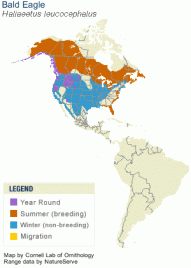Alaska Species Explorer

All
x
- – No known individuals remaining.
- – Known only to survive in captivity, or as a naturalized population outside its historic range.
- – Extremely high risk of extinction in the wild.
- – High risk of extinction in the wild.
- – High risk of endangerment in the wild.
- – Likely to become endangered in the near future.
- – Lowest risk. Does not qualify for a higher risk category. Widespread and abundant taxa are included in this category.
- – Not enough data to make an assessment of its risk of extinction.
- – Has not yet been evaluated against the criteria.
Bald Eagle
- – No known individuals remaining.
- – Known only to survive in captivity, or as a naturalized population outside its historic range.
- – Extremely high risk of extinction in the wild.
- – High risk of extinction in the wild.
- – High risk of endangerment in the wild.
- – Likely to become endangered in the near future.
- – Lowest risk. Does not qualify for a higher risk category. Widespread and abundant taxa are included in this category.
- – Not enough data to make an assessment of its risk of extinction.
- – Has not yet been evaluated against the criteria.
The Bald Eagle’s recovery is a spectacular conservation success story.On August 9, 2007, the bald eagle was removed from the federal list of threatened and endangered species. After nearly disappearing from most of the United States decades ago, the bald eagle is now flourishing across the nation and no longer needs the protection of the Endangered Species Act. Although they are no longer listed as endangered, they are still federally protected by the Migratory Bird Treaty Act and the Lacey Act.
Adult Bald Eagles have white heads and tails with dark brown bodies and wings. Their legs and bills are bright yellow. Immature birds have mostly dark heads and tails; their brown wings and bodies are mottled with white in varying amounts. Young birds attain adult plumage in about five years.
Salmon, herring, shad, and catfish, birds, reptiles, amphibians, invertebrates such as crabs, and mammals including rabbits and muskrats.
Bald Eagles are most widespread during winter, where they can be found along coasts, rivers, lakes, marshes and reservoirs in many states. They winter in large numbers at some lakes and national wildlife refuges. They prefer tall, mature coniferous or deciduous trees that afford a wide view of the surroundings.
- The largest bald eagle nest on record was found in St. Petersburg, Florida
- Can live up to 28 years in the wild and 36 years in captivity
- Capable of floating, they may use their wings to “row” over water too deep for wading

















